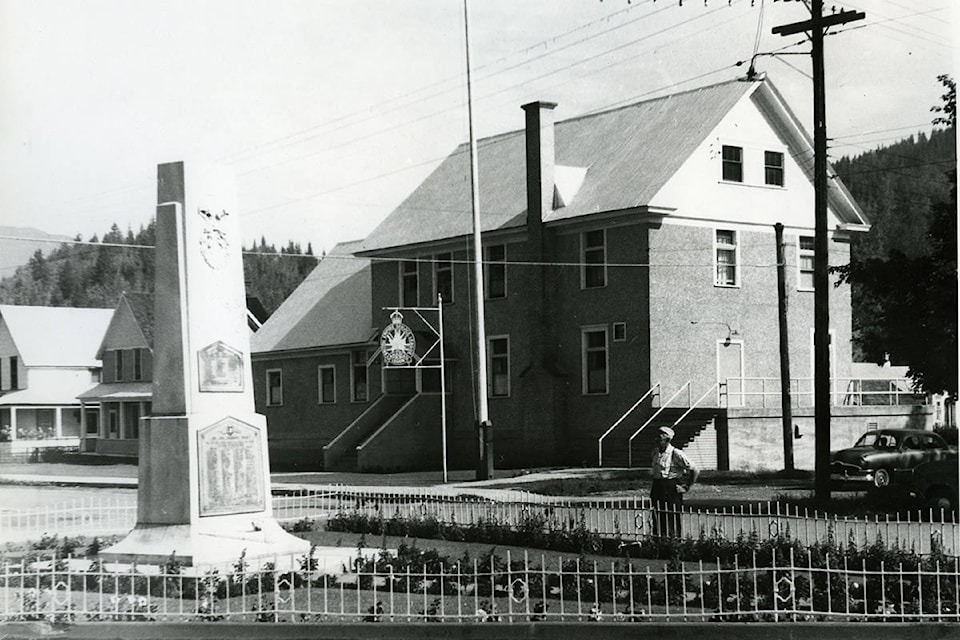Cathy English
Revelstoke Museum & Archives
Every year on Nov. 11, people throughout Canada gather at their local war memorials to remember those who lost their lives in service to their country.
When Armistice was declared at 11 a.m. on Nov. 11, 1918, the people of Revelstoke responded with relief and joy, but it was tinged with sadness.
Over the course of the past four years, more than 700 men had left the community to serve in the war, and about 100 of them never returned.
The Armistice parade in Revelstoke was slightly delayed to allow for the funeral of Allan Daniel McDonald, a recently returned solider, who died the day before of what was known as “trench fever.”
After the funeral procession made its way to the CPR station for McDonald’s body to be sent back to his family in the Maritimes, the victory parade wended its way through the streets of Revelstoke, with schoolchildren, residents and returned soldiers all coming out to mark the end of the terrible conflict.
It took many months after the end of the conflict for all of the soldiers to finally make their way back to Canada. The lack of available troop ships meant that thousands of men were waiting anxiously in Belgium and England.
Revelstoke was a dispersal station, where men could come for their official discharge.
The community welcomed the returned soldiers, setting up temporary housing, and a mess hall to feed them while they were in town.
The 54th Kootenay Battalion, made up of men from Revelstoke, and other towns in the Kootenays and the Okanagan, arrived in town in June of 1919.
They paraded to the Recreation Grounds (now Queen Elizabeth Park) where they were given a rousing welcome back to Canada.
The people of Revelstoke felt strongly that the men who had sacrificed their lives for their country must be remembered for all time.
The Women’s Canadian Club arranged for a memorial plaque to be created and placed on the courthouse. This bronze plaque was unveiled by the H.R.H. Edward, Prince of Wales on Sept. 20, 1919.
The Great War Veteran’s Association formed in 1918, and in Oct. of 1919 the organization moved into the former hospital building. The G.W.V.A. became the Royal Canadian Legion in 1925.
The G.W.V.A. felt that the community should have a permanent cenotaph, rather than simply the plaque on the courthouse.
They began fundraising for the cenotaph, and decided that a new plaque would be prepared, as some of the names on the courthouse plaque were incorrect.
At the time that the cenotaph was to be built, there was a street known as Government Road. that angled from Victoria Road to Third Street, cutting through the former Mountain View School property. The last vestige of this angled road can be seen on what is now Pearson Street, alongside the Lordco store.
The City of Revelstoke granted a small triangle of land at the intersection of First Street, Garden Avenue and Government Street for the cenotaph.
The War Committee raised funds through a benefit play and by running a refreshment stand at the Ski Festival and through donations.
The total cost for the Cenotaph project was $3,370, including $2,600 for the cenotaph itself and $475 for the bronze tablet.
The monument was made of white hammered granite by the B.C. Monumental Works of New Westminster, and the bronze tablet was made by O.B. Allan, Jeweler of Vancouver.
In a letter to the War Memorial Committee dated July 23, 1923, the manager of the B.C. Monumental Works states: “The bronze tablet is, in our opinion, very fine indeed and by far the best we have seen used on any war memorial so far put up by this company.”
On Sept. 2, 1923, a large crowd gathered in front of the new war memorial. The Revelstoke Band and combined choirs from all of Revelstoke’s churches were present to lead the music at the service.
The Cenotaph was unveiled by Brigadier General Victor W. Odlum with the following words: “Greater love hath no man than this: that a man lay down his life for his friend.
In grateful recognition in the service they have performed for us, our Dominion, for the Empire and for civilization, and in recognition, too, of the great price they paid in giving that service, in the name of the citizens of Revelstoke, I unveil this monument to them.”
Memorial tablets were added after World War II and after the Korean War. Once Government Road was closed in the 1960s, the cenotaph was moved to its present location.
After the end of World War II, some of the war casualties were remembered in enduring monuments, with geographical features named after them.
In this area, Drimmie Creek, Holyk Creek, and Pulley Creek, all south of Revelstoke, are named after Gordon Drimmie, Nicholas Holyk, and Harry Pulley.
Mount English, west of town, was named after George English, and McCrae Peak, a popular hiking area south of Revelstoke, was named after Donald McCrae, a well-known local skier.
Hans Gunnarsen, another local ski champion, was remembered by Mount Gunnarsen, near Arrowhead.
Cathy English is with Revelstoke Museum & Archives.
